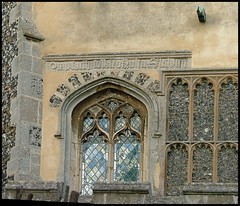
home I index I latest I glossary I introductions I e-mail I about this site
St Andrew, Northwold
Read
the captions by hovering over the images, and click on them to
see them enlarged.

St
Andrew, Northwold
Northwold has a rather eccentric policy towards pilgrims and strangers. The good news is that the church is open to visitors daily. But, come four o'clock, they lock up; and not just the church, but all the entrances to the graveyard. A notice tells you that if you are seen on the grounds after that time, they'll call the police. Further, if you are a teenager, they'll tell your parents and your school. The notice informing you of this would have more authority if it wasn't for the errors - maybe they could find some teenagers and ask them how to spell authourised and premisis. But this is nit-picking, because St Andrew is a splendid building that is also generally welcoming, in an area where many churches are kept locked. You step into a large space which is, at first sight, almost entirely Victorianised. There is none of the endearing rustic shabbiness you'll find not far off at Gooderstone and Foulden. Rather, this is a building full of the confidence of the late 19th Century Church. Its urban anonymity must have seemed more in keeping when the busy road passed by, but in fact this building contains much of interest, and some of it a little unusual. The great surprise of the interior is that, despite the impressive late Perpendicular exterior, the elegant arcades are those of two centuries earlier. Pevsner points out that the most westerly bays are later replacements, probably from the 14th century, as if a tower was planned. But it would not be built for another hundred years. But Northwold's most famous feature is the spectacular Easter Sepulchre up in the largely 19th century chancel. It is probably the best in Norfolk, despite its battered appearance. The most interesting feature is that the Roman soldiers at the base, waking in confusion to witness the Resurrection, are wearing late medieval armour. Just a fragment of the Three Living and Three Dead wall painting in the north aisle survives, but it is a delicious little fragment. It depicts the hunting falcon sitting on the wrist of one of the Three Living, as they meet the walking corpses of the Three Dead in the forest, to be told As we are so you shall be, therefore prepare to follow me. The view westwards from beneath the chancel arch is stately and urban, a building full of confidence, but along the walls are reminders that this was a significant place in the 18th century. Some fine stone tablets are guarded by putti with faces depicting their grief and astonishment, and the inscriptions are very models of the sentiments of the period. Ann Hopkin, we are told, was an Indearing Wife, An Indulgent Mother, An Affectionate Relation, An Honour to her Family and An Ornament of her Sex. When she died in 1732 at the age of just 22, her husband also recorded that two of their children were before interr'd in the same grave. |
Simon Knott, November 2008
Amazon commission helps cover the running costs of this site.
home I index I latest I introductions I e-mail I about
this site I glossary
Norwich I ruined churches I desktop backgrounds I round tower churches
links I small
print I www.simonknott.co.uk I www.suffolkchurches.co.uk